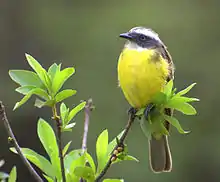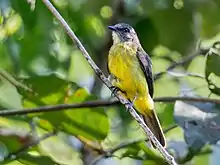Myiozetetes
Myiozetetes is a small genus of passerine birds in the tyrant flycatcher family. The four species occur in tropical Central and South America.
| Myiozetetes | |
|---|---|
 | |
| Social flycatcher (Myiozetetes similis) | |
| Scientific classification | |
| Kingdom: | Animalia |
| Phylum: | Chordata |
| Class: | Aves |
| Order: | Passeriformes |
| Family: | Tyrannidae |
| Genus: | Myiozetetes P.L. Sclater, 1859 |
| Type species | |
| Muscicapa cayanensis Linnaeus, 1766 | |
| Species | |
|
see text | |
Taxonomy
The genus Myiozetetes was introduced by the English zoologist Philip Sclater in 1859 with the rusty-margined flycatcher as the type species.[1] The name of the genus combines the Ancient Greek muias "fly" and zētētēs "searcher".[2]
Species
The genus contains four species:[3]
| Image | Scientific name | Common Name | Distribution |
|---|---|---|---|
.jpg.webp) | Myiozetetes cayanensis | Rusty-margined flycatcher | Bolivia, Brazil, Colombia, Ecuador, French Guiana, Guyana, Peru, Suriname, and Venezuela; also eastern Panama. |
 | Myiozetetes similis | Social flycatcher | from northwestern Mexico south to northeastern Peru, southern Brazil and northwestern Argentina |
.jpg.webp) | Myiozetetes granadensis | Grey-capped flycatcher | eastern Honduras south to northwestern Peru, northern Bolivia and western Brazil |
 | Myiozetetes luteiventris | Dusky-chested flycatcher | Bolivia, Brazil, Colombia, Ecuador, French Guiana, Peru, Suriname, and Venezuela |
Description
The adult Myiozetetes flycatcher is 16–18 cm (6.3–7.1 in) long and weighs 24–30 g (0.85–1.06 oz). The upperparts are olive-brown, and the wings and tail are brown with only faint rufous fringes. The underparts are yellow and the throat is white. Young birds lack the red-orange crown stripe of the adult, and have chestnut fringes to the wing and tail feathers. The best distinction between the species is the head pattern: Vermilion-crowned, social and rusty-margined flycatchers have strong black-and white head markings like the great kiskadee, whereas grey-capped and dusky-chested flycatchers have greyish heads, with a short weak eyestripe in the former.
Myiozetetes flycatchers sally out from an open perch in a tree to catch insects in flight. They sometimes hover to take small berries. They breed in cultivation, pasture, and open woodland with some trees, building a large roofed nest from stems and in a bush, tree or on a building. The nest is often constructed near a wasp, bee or ant nest, or the nest of another tyrant flycatcher. The nest site is often near or over water. The typical clutch is two to four brown or lilac-blotched cream or white eggs, laid between February and June.
References
- Sclater, Philip Lutley (1859). "Descriptions of new species of the American family Tyrannidae". Proceedings of the Zoological Society of London. 27 (1): 40-46 [45, 46].
- Jobling, J.A. (2018). del Hoyo, J.; Elliott, A.; Sargatal, J.; Christie, D.A.; de Juana, E. (eds.). "Key to Scientific Names in Ornithology". Handbook of the Birds of the World Alive. Lynx Edicions. Retrieved 1 July 2018.
- Gill, Frank; Donsker, David, eds. (2018). "Tyrant flycatchers". World Bird List Version 8.2. International Ornithologists' Union. Retrieved 1 July 2018.
- Hilty, Steven L. (2003): Birds of Venezuela. Christopher Helm, London. ISBN 0-7136-6418-5
- Stiles, F. Gary & Skutch, Alexander Frank (1989): A guide to the birds of Costa Rica. Comistock, Ithaca. ISBN 0-8014-9600-4
